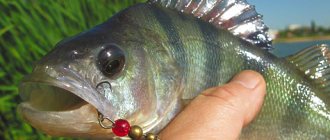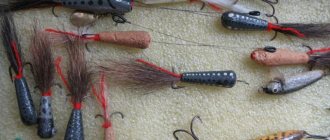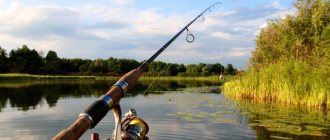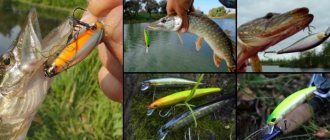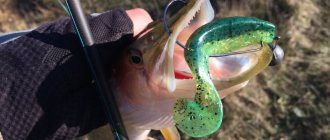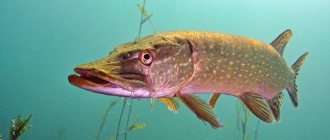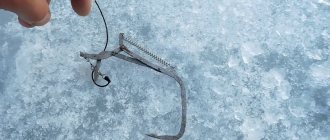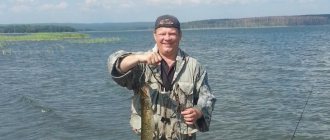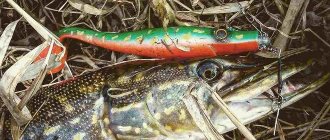Having previously assessed the information received from the fishermen and the nature of the river from the map, we disembark at a given place convenient for access to the river, and raft along the route to the appointed place. Obviously, the one who goes first along the route has a better chance of a good catch. Therefore, it is better to raft on your own or in a small, trusted company with an interval of 20 minutes. When first exploring a section of the river, the catches are usually not impressive. After going through the route several times, you will already know exactly where the fish are and what interval of the river can be ignored. Well, the fish stands where nature has created shelters for it from snags, fallen trees, rubble, bare roots, flooded and overhanging bushes, etc. Catching pike from a boat in deserted places is also an opportunity to plunge into the picturesque world of wildlife.
?? so, you are in a boat. There is indescribable beauty around you, created by Mother Nature, not a soul, and you find yourself face to face with a snag. Float by? Stupid. After all, it hides something for which you are ready to run hundreds of kilometers. Perhaps it is she who hides that long-awaited trophy that you have been dreaming about for several years. Well then, let's get to work. Any tree fallen into water or flooded is individual. You won’t find another one like it anywhere on the globe. Consequently, there can be no talk of any templates for fishing tactics. But fishing already does not accept templates, although we, anglers, always strive to generalize and search for the best method of fishing and the most catchy bait. So let's do the same in this case. Let's remember the most common situations on the river and discuss them.
Fishing for a fallen tree or a snag sticking out of the water is a delicate matter and requires delicacy in everything. First of all, in the gear (rod, reel, bait). And, of course, success always depends on the accuracy of casting the bait. Sometimes an inaccurate cast can spook a cautious asp or a decent-sized chub. Therefore, personally, before I swim closer to a fallen tree, I throw the bait in front of the tree and let it float to the required distance. And then I begin to slowly wind up against the current. In most cases, this technique turns out to be the most effective.
How to catch trophy pike in snags
Example 1. We catch trees that have fallen into the river
The first, fairly common example. The roots of the tree were washed away by the current, and the tree fell into the water. The tree trunk may lie completely or partially on the water. The rhizome can remain on the shore, then only the branches and part of the trunk are immersed in water (Fig. 1).
In both cases, you need to start fishing for snags from position 1, casting directly to the tree trunk, starting closer to the shore and further to the riverbed. If possible, you need to let the bait sink under the trunk. It is better to use a small sinking wobbler as bait, for example, YO-ZURI L-MINNOW - 44 or L-MINNOW - 66. The advantage of sinking wobblers for these purposes is undeniable. Firstly, they hold the stream perfectly, and secondly, they allow you to fish at the desired depth. When casting closer to the shore and tree trunk, there is a high probability of a pike or large perch biting. Starting fishing from position 1 is advantageous, since when biting, it is unlikely to scare another fish standing behind a snag. After the tree trunk is fished from the front, you need to move a little to the riverbed (position 2) so that you can cast straight to the top of the tree. Having cast to the top of a fallen tree, it is necessary to allow the bait to float downstream at a distance of 3 - 5 meters behind the tree, where a stream forms and where bleak always frolics, chub, roaches and perches stand. A pike stands at the bottom under the stream, attracted by the frolicking small fry.
About
Rod and other elements for snag fishing
We will need a rod strong enough to withstand the effort when we have to pull out the bait stuck in the snags. The spinning test ranges from 10 to 50 grams. The build must be fast. That is, this is a rigid rod that can be used to forcefully fish and reel out equipment. The length of the spinning rod is 2.4-2.7 meters.
We use a power reel with a spool capacity of 3000 to 4000. It must withstand heavy loads, which are sure to happen. Be sure to wind a cord with a breaking load of 10 kg onto the spool. It will allow you to read the bottom and understand where the weight is jumping along the snags and where along the bottom. Braid is more durable and will sometimes allow you to either straighten the tee or simply remove the bait when pulling out a snag by force.
Should I put a leash on or not when fishing in snags? In most cases, bet, since pike often visit such places and fighting it without a steel leash is an unpromising activity. The best option is a leash made from a guitar string and a metal knotless one, which is attached to the cord, and to it a leash with a carabiner. Instead of guitar strings, you can use strands from field cable.
For fishing in snags, it is better to use offset hooks and single hooks with a straight bend or slightly bent inward. We resolutely refuse tees and doubles. They significantly increase the likelihood of snags.
Tackle and equipment of a spinning angler when fishing on the river
You need to prepare for river trips. Equipment should be convenient and comfortable. After all, you will have to spend almost the whole day on the boat. It is better to wear rubber boots on your feet - sometimes you need to go ashore, and the shore is not always sandy. For small accessories, it is better to get a multifunctional vest. To store fish you need to have a reliable cucan made of thin wire. Sometimes you can get caught in short-term rain, and sometimes in prolonged rain. There is nowhere to hide. This is where taking a cloak or cape with you will save you.
To land fish, you will need a landing net equipped with a large mesh net made of thick fishing line.
The choice of rod and reel directly depends on the type of bait you are going to fish with. But what to use, braided cord or monofilament line, is a controversial issue. But the fact that when using monofilament fishing line there are three times more bites than when using cord is a proven fact.
Having a large number of baits in a fishing box is not a fishing fetish, but an everyday necessity when fishing in difficult snags. But the presence of expensive gear (rod, reel, line) is not snobbery, but a healthy desire for perfection. High-quality gear is not designed for wealthy fishermen, but for sports fishermen who know a lot about them and their capabilities. Remember this.
Of course, what to do and what tactics to choose must be assessed in each individual case. Remember that fishing does not accept templates. Yesterday the water was clear, but today it is cloudy after rain. Yesterday the water in the river fell, but today it rose, etc. That’s why pessimists came up with the phrase: “The best bite was yesterday and tomorrow.” Optimists, having not caught a fish, thank fate for an extraordinary vacation away from the metropolis.
Views: 93
Similar articles:
- How to catch pike in the fall on the river The climate of our country has become more and more...
- Catching pike with a jig in the fall How to catch pike with a jig in the fall and where to look for a toothy...
- How to properly catch pike with a spinning rod: tackle, choice of bait, fishing technique Active search for fish for me is always the beginning of fishing...
- Catching pike in the fall with a spinner I don’t know how right I am, but it seems to me that a spinning rod...
Spinning in river snag
Once I was fishing on a small river, and a thought suddenly occurred to me: why are there no other fishermen nearby? Although on the way to the river I saw that on the floodplain oxbow lakes there were a lot of fans of both spinning rods and fishing rods. I was so overcome with curiosity that I had to walk back half a kilometer to the nearest oxbow lake to ask fellow hobbyists about the reasons for this. What added to the bewilderment was that their catches included small perch and small pike weighing 300-400 grams each. To my question: “Why do you fish not on the river, but here, because the fish are small?” “I received an amazing answer: “What should I do there, tear off the hooks?!” The fear of losing the bait due to snags is the main reason why many spinning anglers avoid snags in rivers. And, in my opinion, in vain. After all, snags on the river are the very places where, first of all, you need to cast, because this is where there is a chance to catch the largest fish.
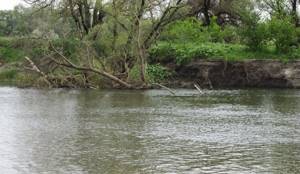
Let's try to determine the reasons why a huge mass of fishermen ignore snags in rivers. The first one has already been named - this is a high probability of losing baits on hooks. The second, and no less significant, is the inaccessibility of such places. Usually the situation is like this: if there are snags below, in the water, then there are impassable thickets on the shore. And few people want to wade through them. On the plus side is the inconvenience of casting, thorns, nettles, etc. And if a spinning player has a boat, this also poses certain difficulties with assembling and disassembling, launching it into the water, etc. What can be said about this? There’s only one thing: you can’t even take a fish out of the pond without difficulty. This is just about our case, fishing in snags is labor.
Driftwood, they are different
The object of my attention is rivers, primarily medium and small ones. Let's figure out how we can fish with them in difficult conditions of interweaving branches and trunks, and how not to be afraid of such places? Many have probably noticed that at some points on the river a stable predator bite is observed throughout the entire season, but at some points that seem to be similar in type, there are no bites at all. The same is true with driftwood.
A river is a current, strong or weak, but it is always there. Tree trunks and coastal bushes that have fallen into the water weaken this very current. This is especially true for rivers with serious flow speeds. Fish, predatory or peaceful, willy-nilly must look for places with weakened currents, simply to rest or feed. There is one more thing that attracts a predator to snags. A pile of branches and trunks is simply an ideal place for an ambush. Carefully positioning itself in the subsiding current behind a fallen tree, a pike can wait for hours for a gaping fish - and then attack from cover. Thus, the toothy one, as it were, kills two birds with one stone - it stands in a quiet place, without wasting energy fighting the current, and at the same time hunts to replenish this same energy. Effective? Yes, everything is rationally thought out in nature.
The scenario may be slightly different. Why, in a river with a very slow current, when it is practically not felt, would a predator go to the snags, because it does not need to fight the flow at all? Just to hide. Ambush is the main goal of a predator in a snag. Of course, this pattern of behavior is inherent mainly in pike. But both perch and pike perch do not hesitate to hunt for fry from cover, moving from snag to snag.
Why is there a predator behind some snags, but not behind others? Let's imagine a situation - a river, a current, along the banks there are thickets of bushes, a forest. All this is sooner or later washed away by the stream and falls into the water, but not every fallen tree or bush forms a good place. Successful not for us, but for the predator. In my opinion, the first and only condition for the presence of a pike or perch behind a tree or bush that has fallen into the water is the presence of small fish there. If there is none, then there will be no predator. So what you need to look for is not pike (we practically cannot see it in the river), but “white” fish. Of course, there are modern devices for this - echo sounders and structure scanners, but since we are talking about coastal fishing, polarized glasses will help us find “white” fish. They allow you to cut off the glare of the sun from the water and see more clearly what is happening there, behind the surface of the water in the depths. This property is especially evident if the water is clean, and in the autumn it usually is. But even if the water is not crystal clear, then if we are a little more attentive, we will still easily notice small fish scurrying around in the near-surface layer.
Read: Finding a place to catch pike on a girder
In general, the tactics are simple. We walk along the shore and look out for snags. If an interesting place forms behind it, then, as a rule, it is not extended, only a few meters. Now it’s worth stopping and observing for a few minutes. If a small fish scurries around a snag, circles spread out and you can see small fish - bleak, dace, etc., then you can safely linger here. The chances of a predator biting in this place are high. This is especially true from mid-autumn until freeze-up. At such times, all the fish concentrate in certain places and searching for such places is one of the conditions for successful fishing.
How not to be afraid to throw where others do not advise
Let's assume that we found the fish. But what to do next, and, most importantly, what to catch it with? When we fish in snags, our eyes stumble upon branches sticking menacingly out of the water - and our mind literally resists casting the bait. There may be several options for equipment for fishing among snags. Here I offer fishing methods that I have tried myself, and from my own experience I speak about their effectiveness. Let's try, as they say, to set priorities.
The first, and probably the most basic way of fishing in such places is jig. It's simple, fast, mobile and non-sticky. Spinners went to all sorts of tricks to protect the hook from contact with snags. These are wire “whiskers” on the jig head, and special bends on the silicone body of the bait in which the hook was hidden. I liked the “oblique installation” better. The principle is this: we take the most ordinary jig head and pierce the body of the twister with a hook at the very beginning, then we pierce the bait again, but we do not take the hook out, but leave it inside. This went on for several years until, in the early 2000s, offset hooks became available to the mass Russian fisherman. And now almost all fishing trips where a non-snacking rig is needed are carried out with an offset rig. With it you can fish in the most remote snags and not be afraid of tearing off the bait. It’s impossible to say that there will be no snags at all, but if there are any, they will be minimal. The principle of constructing a jig rig in our case will be as follows: a metal leash, an eared weight, popularly called a “Cheburashka”, an offset hook, and a silicone bait.
The next installation method is the so-called Texas equipment. We leave the same four components of the gear as in the previous equipment, only instead of the “Cheburashka” we take a lead or some other “bullet” with a hole in the middle and string it on a metal leash. This increases the snag-freeness of the tackle, if not to 100, then to 99.9% exactly. Due to the fact that the “bullet” does not have any external protruding elements, its maneuverability among branches and various other “wood” is very high.
Simple wacky
There are situations when pike and perch refuse to attack the jig and its Texas modification. Then you can offer a secret weapon - the wacky rig. “Secret” not in the sense that no one knows it, but in the sense that few people use it. There were publications in magazines, articles and videos on the Internet, but wacky never gained popularity among us. For snags, this fishing method is very suitable. Although it is impossible to say that it does not cling to branches and snags. It clings, especially in its classic version, with an open hook. I slightly changed the classic “wacky” rig, making it so that it was convenient to quickly switch from one fishing method to another - for example, from a wecky to a jig, and vice versa. Let me explain. The traditional “weki” uses a special hook: either open or protected from snags by special plastic whiskers. However, these same hooks can not be found in the assortment of every fishing store, even on the Internet, not to mention provincial shops. I had such hooks, I actively used them, but on one of the fishing trips I discovered that I had forgotten these special hooks. And I decided to try to attach a silicone bait using the “wacky” principle, piercing it in the middle with a regular 3-gram jig head. On that fishing trip I caught a good perch, plus there were several more contacts of pike. In general, such a simple installation works, and if it does its job, then why complicate it? So it happened: if I need to lower the bait vertically and slowly play it near the snag, I remove the silicone bait from the “offset” or the hook of the jig head, attach it from the middle - and forward (photo 8). I use light jig heads - 2 - 5 g, depending on the current. Of course, there are some nuances here. Firstly, the mass of the lead weight should be much less, as if we were fishing with a jig in the same place. Otherwise, you won’t get a high-quality “game” of the bait - it will simply fall down like a stone, and even a fast pike won’t have time to react. The second point is that when using a jig head in this equipment, there is a poor implementation of bites. At least, that's my opinion. You have to be on the alert all the time, but if you get lazy, the predator’s attack ends in nothing. But how many emotions such fish coming to the bait bring. Fishing in autumn light water is literally under your feet, and with polarized glasses you can clearly see the shadow of the fish, hit in the hand, then it’s all up to you.
Read: Fishing with a float in snags
Wiring nuances
We have decided on the technical equipment for snags, and now we will try to answer the question - how to catch? In general, the placement of the bait will differ significantly depending on the type of river you are fishing on: rivers with a slow current will have their own characteristics, and rivers with a fast current will have their own. Let's try to simulate some of the nuances of fishing.
So, the location of the fish has been determined. What to do next? Usually on rivers the snag is compact: it is either a bush that has fallen into the water or a tree. Less common are sections of the river whose banks are completely covered with fallen trees. In the current, we are unlikely to be able to complete a full-fledged long retrieve of several tens of meters. Therefore, even if the snag is extensive, it is best to focus on fishing specific points, rather than throwing bait in an unknown direction and trying to fish “in areas”; such tactics are unlikely to bring many bites. The fact is that on a river where there is a decent current, behind almost every bush or tree that has fallen into the water, an area of quiet water forms, and this is where you can expect an attack from a predator. You should always start with a jig; it will also act as a scout, and if pike and perch are active, it will certainly bring a bite. We try to cast downstream or at an angle to it. If you cast upward, the bait will be carried under the snag by the stream, then even an offset hook will not protect it from the inevitable snag. But on slow-flowing rivers it is possible and even necessary to fish in areas. If there are also serious depths in such a quiet river, then it is not always possible to recognize snags, because some of them are hidden under water, and due to the slow speed of the flow, there is no disturbance on the surface - and it is difficult for us to understand whether there is a snag there or not. For such situations, the jig will act as a scout; by feeling it in our hand, we identify underwater snags and begin to purposefully fish for them.
Read: Fishing for pike in deep water
If the jig does not bring a bite, then there may be options: either you move to the next point and fish it and so on in search of an active predator, or you try to “persuad” the fish here by changing the method of presenting the bait. You can try to use the same jig, but hold it not in the classic “step” way, but in the American style. After casting under the snag, we wait for the bait to drop and begin lifting it from the bottom, not with a reel, but with a rod, twitching upward and picking up the slack in the cord with the reel. The “American jig” is especially good on rivers with a current, when, due to mixing streams, it is difficult to control the fall of the bait to the bottom, as if we were fishing with a classic “Russian jig.” You can vary the weight of the lead weight (“Cheburashka” or “bullet”) to choose the best option that the fish will like.
And finally, if all your previous attempts did not bring bites, the only thing left is the “wacky”, which often helps out when the pike is seriously passive. The animation of the silicone equipped with the weki method is both simple and complex. In the sense that this fishing requires a little more thoughtfulness and concentration. We have already talked about the installation diagram itself, now about the wiring options.
Let's start with the fact that in this case we do not need long casting; fishing is carried out at local points behind snags. We throw the bait (and it can be a silicone “worm”, “crustacean”, twister) directly under the snag, wait for it to sink, and not necessarily to the very bottom, and begin to slowly twitch and hover the bait in place. Most of the bites occur during the fall and the first seconds of the dive, or when the bait has already descended and you are just starting the animation. For “wheki”, snags and logs are best suited, behind which there is no current at all or it is minimal, so that you can put a weight of several grams. Fancy forms of “silicone” behave especially interestingly on the Vaki rig, and it is desirable that they have numerous branches. Such baits play seductively and can provoke even an inactive pike or perch to attack. The only annoying aspect of my “veki” design is its snagging. But it is not all that bad. We fish close to the shore, so often a thick cord helps, as they say, to tear through the hook or straighten it. If the water is light, you can also see how our bait moves - and, if possible, avoid obstacles, which is possible in most cases.
Bright cord and strong spinning rod
A good quality 4-core cord is suitable for this type of fishing. It is not afraid of abrasive, rubs less against underwater branches and can withstand good loads. And the load on the tackle when fishing in snags is very serious. The diameter of the braided line should not be reduced: 0.16 mm (or # 1.0 according to the Japanese classification), less is not necessary. After all, if you catch a large pike, and there are often such ones behind snags, you will have to do forced fishing. The color of the “braid” needs to be eye-catching: it is difficult to control the line “in the hand” during such fishing, and a bright cord allows you to see not only the bait falling to the bottom, but also touching branches and trunks under water. I usually use white, orange or yellow cord.
We also choose a rod to match the cord: powerful and reliable. For local fishing behind snags, a short spinning rod (up to 2.1 m) is better suited, and for working “in areas” you can take a slightly longer tool - up to 2.4 m. Fishing on snags in rivers is exciting and interesting. Each new snag promises a bite from a predator, you have to move around a lot, look for and try fishing options. And if you manage to find the right place and the fish attacks your bait, fighting a predator in cramped conditions will give you a lot of positive emotions, because that’s what we fish for.
snag
